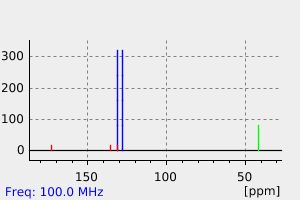2-(4-氯苯基)乙酰胺 | 20101-92-2
中文名称
2-(4-氯苯基)乙酰胺
中文别名
——
英文名称
2-(4-chlorophenyl)acetamide
英文别名
(4-chlorophenyl)-acetamide;p-chlorophenylacetamide;p-Chlorphenylacetamid
CAS
20101-92-2
化学式
C8H8ClNO
mdl
MFCD02380705
分子量
169.611
InChiKey
BFYGROHYLCZLGS-UHFFFAOYSA-N
BEILSTEIN
——
EINECS
——
-
物化性质
-
计算性质
-
ADMET
-
安全信息
-
SDS
-
制备方法与用途
-
上下游信息
-
文献信息
-
表征谱图
-
同类化合物
-
相关功能分类
-
相关结构分类
物化性质
-
熔点:183-185 °C
-
沸点:344.9±25.0 °C(Predicted)
-
密度:1.256±0.06 g/cm3(Predicted)
计算性质
-
辛醇/水分配系数(LogP):1.5
-
重原子数:11
-
可旋转键数:2
-
环数:1.0
-
sp3杂化的碳原子比例:0.125
-
拓扑面积:43.1
-
氢给体数:1
-
氢受体数:1
安全信息
-
危险性防范说明:P280
-
危险性描述:H302,H317
-
储存条件:存放在室温下,并保持干燥和密封。
上下游信息
-
上游原料
中文名称 英文名称 CAS号 化学式 分子量 2-苯乙酰胺 Benzeneacetamide 103-81-1 C8H9NO 135.166 对氯苯乙酸 4-chlorophenylacetic Acid 1878-66-6 C8H7ClO2 170.595 对氯苯乙酰氯 4-chlorophenacetyl chloride 25026-34-0 C8H6Cl2O 189.041 对氯苯乙酸甲酯 (4-chloro-phenyl)-acetic acid methyl ester 52449-43-1 C9H9ClO2 184.622 对氯苯乙腈 p-chlorobenzyl cyanide 140-53-4 C8H6ClN 151.595 2-(4-氯苯基)-N-羟基乙脒 2-(4-chlorophenyl)-N-hydroxyacetimidamid 6965-39-5 C8H9ClN2O 184.625 对氯苯乙酮 para-chloroacetophenone 99-91-2 C8H7ClO 154.596 -
下游产品
中文名称 英文名称 CAS号 化学式 分子量 4-氯苯基硫代乙酰胺 4-chlorophenylthioacetamide 17518-48-8 C8H8ClNS 185.677 —— N-benzyl-2-(4-chlorophenyl)acetamide 82082-47-1 C15H14ClNO 259.735 对氯苯乙腈 p-chlorobenzyl cyanide 140-53-4 C8H6ClN 151.595 4-氯苯乙醇 2-(4-Chlorophenyl)ethanol 1875-88-3 C8H9ClO 156.612
反应信息
-
作为反应物:描述:参考文献:名称:未保护的苄基四唑的锂取代。摘要:1H-四唑在现代药物化学中起着重要的作用,但是很少有对其进行修饰的方法。许多现存的方案要求使用难以除去的N-烷基保护基,排除了将产物用作羧酸酯生物等排体,这是四唑类在药物中的主要作用。我们在此报告了苄基四唑的方便,无保护基团的锂取代反应方案。在0°C下用n-BuLi进行金属化,然后进行亲电捕集,可得到一系列α-官能化的苄基四唑,收率高达91%。DOI:10.1021/acs.orglett.9b02633
-
作为产物:描述:对氯苯乙酸 在 草酰氯 、 ammonium hydroxide 作用下, 以 四氢呋喃 、 N,N-二甲基甲酰胺 、 水 、 N,N-dimethyl-d6-formamide 为溶剂, 反应 32.0h, 生成 2-(4-氯苯基)乙酰胺参考文献:名称:未保护的苄基四唑的锂取代。摘要:1H-四唑在现代药物化学中起着重要的作用,但是很少有对其进行修饰的方法。许多现存的方案要求使用难以除去的N-烷基保护基,排除了将产物用作羧酸酯生物等排体,这是四唑类在药物中的主要作用。我们在此报告了苄基四唑的方便,无保护基团的锂取代反应方案。在0°C下用n-BuLi进行金属化,然后进行亲电捕集,可得到一系列α-官能化的苄基四唑,收率高达91%。DOI:10.1021/acs.orglett.9b02633
文献信息
-
Selective Hydrolysis of Nitriles to Amides Using NaOH-PEG Under Microwave Irradiation作者:Pravin M. Bendale、Bhushan M. KhadilkarDOI:10.1080/00397910008087213日期:2000.4Abstract We describe here an efficient, rapid and selective method for the conversion of nitriles in to their corresponding amides in the presence of PEG-400, aqueous sodium hydroxide system under microwave irradiation.
-
Synthesis of α-Arylcarboxylic Acid Amides from Silyl Enol Ether via Migratory Amidation with 2-Azido-1,3-dimethylimidazolinium Hexafluorophosphate作者:Mitsuru Kitamura、Kento Murakami、Yuichiro Shiratake、Tatsuo OkauchiDOI:10.1246/cl.130195日期:2013.7.5α-Arylcarboxylic acid amides were synthesized by reacting silyl enol ethers of aryl ketones and 2-azido-1,3-dimethylimidazolinium hexafluorophosphate (ADMP, 1). Silyl enol ethers react with ADMP 1 to give N-(α-arylacyl)guanidines via the migration of aryl groups in enol ethers. The products were transformed to the corresponding α-aryl acetamides by treating with LiAlH4.
-
一种含炔基的芳基酰胺类衍生物及其制备方法和应用申请人:广东工业大学公开号:CN109942616A公开(公告)日:2019-06-28
-
<scp>Regio‐Divergent</scp> C—H Alkynylation with Janus Directing Strategy <i>via</i> Ir( <scp>III</scp> ) Catalysis作者:Xianwei Li、Guangxin Liang、Zhang‐Jie ShiDOI:10.1002/cjoc.202000204日期:2020.9Directing strategy has been extensively exploited to maintain activity and selectivity for the rapid access to functionalized molecules and pharmaceutical targets. However, ‘one‐to‐one’ activation model was usually achieved through traditional directing strategy. Herein, we achieved ‘one‐to‐two’ activation model by slight modification of simple and practical ketoxime and amide functionality. With judicious指导策略已得到广泛利用,以保持活性和选择性,以快速获得功能化分子和药物靶标。但是,“一对一”激活模型通常是通过传统的指导策略来实现的。在这里,我们通过对简单而实用的酮肟和酰胺功能进行一些修改,实现了“一对二”激活模型。通过明智地选择导向基团,实现了Csp 3 -H和Csp 2 -H键的炔基化反应,更重要的是,实现了脱氢的Csp 3 -H炔基化,从而实现了药物在区域上的分散后期修饰。
-
Lead Discovery, Chemistry Optimization, and Biological Evaluation Studies of Novel Biamide Derivatives as CB<sub>2</sub> Receptor Inverse Agonists and Osteoclast Inhibitors作者:Peng Yang、Kyaw-Zeyar Myint、Qin Tong、Rentian Feng、Haiping Cao、Abdulrahman A. Almehizia、Mohammed Hamed Alqarni、Lirong Wang、Patrick Bartlow、Yingdai Gao、Jürg Gertsch、Jumpei Teramachi、Noriyoshi Kurihara、Garson David Roodman、Tao Cheng、Xiang-Qun XieDOI:10.1021/jm301212u日期:2012.11.26N,N′-((4-(Dimethylamino)phenyl)methylene)bis(2-phenylacetamide) was discovered by using 3D pharmacophore database searches and was biologically confirmed as a new class of CB2 inverse agonists. Subsequently, 52 derivatives were designed and synthesized through lead chemistry optimization by modifying the rings A–C and the core structure in further SAR studies. Five compounds were developed and alsoN , N '-((4-(二甲氨基)苯基)亚甲基)双(2-苯基乙酰胺)是通过使用3D药效团数据库搜索发现的,并被生物学证实为一类新的CB 2反向激动剂。随后,在进一步的 SAR 研究中,通过修饰环 A-C 和核心结构,通过先导化学优化设计和合成了 52 种衍生物。开发了五种化合物并证实它们是 CB 2反向激动剂,具有最高的 CB 2结合亲和力(CB 2 K i为 22–85 nM,EC 50为 4–28 nM)和最佳选择性(CB 1 /CB 2235 到 909 倍)。此外,破骨细胞生成生物测定表明 PAM 化合物对破骨细胞形成有很大的抑制作用。特别是,化合物26即使在0.1 μM的低浓度下也表现出72%的抑制活性。细胞毒性试验表明,PAM 化合物对破骨细胞生成的抑制作用不是由其细胞毒性引起的。因此,这些 PAM 衍生物可作为开发新型抗骨质疏松药物的潜在先导物。
表征谱图
-
氢谱1HNMR
-
质谱MS
-
碳谱13CNMR
-
红外IR
-
拉曼Raman
-
峰位数据
-
峰位匹配
-
表征信息
同类化合物
(βS)-β-氨基-4-(4-羟基苯氧基)-3,5-二碘苯甲丙醇
(S,S)-邻甲苯基-DIPAMP
(S)-(-)-7'-〔4(S)-(苄基)恶唑-2-基]-7-二(3,5-二-叔丁基苯基)膦基-2,2',3,3'-四氢-1,1-螺二氢茚
(S)-盐酸沙丁胺醇
(S)-3-(叔丁基)-4-(2,6-二甲氧基苯基)-2,3-二氢苯并[d][1,3]氧磷杂环戊二烯
(S)-2,2'-双[双(3,5-三氟甲基苯基)膦基]-4,4',6,6'-四甲氧基联苯
(S)-1-[3,5-双(三氟甲基)苯基]-3-[1-(二甲基氨基)-3-甲基丁烷-2-基]硫脲
(R)富马酸托特罗定
(R)-(-)-盐酸尼古地平
(R)-(-)-4,12-双(二苯基膦基)[2.2]对环芳烷(1,5环辛二烯)铑(I)四氟硼酸盐
(R)-(+)-7-双(3,5-二叔丁基苯基)膦基7''-[((6-甲基吡啶-2-基甲基)氨基]-2,2'',3,3''-四氢-1,1''-螺双茚满
(R)-(+)-7-双(3,5-二叔丁基苯基)膦基7''-[(4-叔丁基吡啶-2-基甲基)氨基]-2,2'',3,3''-四氢-1,1''-螺双茚满
(R)-(+)-7-双(3,5-二叔丁基苯基)膦基7''-[(3-甲基吡啶-2-基甲基)氨基]-2,2'',3,3''-四氢-1,1''-螺双茚满
(R)-(+)-4,7-双(3,5-二-叔丁基苯基)膦基-7“-[(吡啶-2-基甲基)氨基]-2,2”,3,3'-四氢1,1'-螺二茚满
(R)-3-(叔丁基)-4-(2,6-二苯氧基苯基)-2,3-二氢苯并[d][1,3]氧杂磷杂环戊烯
(R)-2-[((二苯基膦基)甲基]吡咯烷
(R)-1-[3,5-双(三氟甲基)苯基]-3-[1-(二甲基氨基)-3-甲基丁烷-2-基]硫脲
(N-(4-甲氧基苯基)-N-甲基-3-(1-哌啶基)丙-2-烯酰胺)
(5-溴-2-羟基苯基)-4-氯苯甲酮
(5-溴-2-氯苯基)(4-羟基苯基)甲酮
(5-氧代-3-苯基-2,5-二氢-1,2,3,4-oxatriazol-3-鎓)
(4S,5R)-4-甲基-5-苯基-1,2,3-氧代噻唑烷-2,2-二氧化物-3-羧酸叔丁酯
(4S,4''S)-2,2''-亚环戊基双[4,5-二氢-4-(苯甲基)恶唑]
(4-溴苯基)-[2-氟-4-[6-[甲基(丙-2-烯基)氨基]己氧基]苯基]甲酮
(4-丁氧基苯甲基)三苯基溴化磷
(3aR,8aR)-(-)-4,4,8,8-四(3,5-二甲基苯基)四氢-2,2-二甲基-6-苯基-1,3-二氧戊环[4,5-e]二恶唑磷
(3aR,6aS)-5-氧代六氢环戊基[c]吡咯-2(1H)-羧酸酯
(2Z)-3-[[(4-氯苯基)氨基]-2-氰基丙烯酸乙酯
(2S,3S,5S)-5-(叔丁氧基甲酰氨基)-2-(N-5-噻唑基-甲氧羰基)氨基-1,6-二苯基-3-羟基己烷
(2S,2''S,3S,3''S)-3,3''-二叔丁基-4,4''-双(2,6-二甲氧基苯基)-2,2'',3,3''-四氢-2,2''-联苯并[d][1,3]氧杂磷杂戊环
(2S)-(-)-2-{[[[[3,5-双(氟代甲基)苯基]氨基]硫代甲基]氨基}-N-(二苯基甲基)-N,3,3-三甲基丁酰胺
(2S)-2-[[[[[((1S,2S)-2-氨基环己基]氨基]硫代甲基]氨基]-N-(二苯甲基)-N,3,3-三甲基丁酰胺
(2S)-2-[[[[[[((1R,2R)-2-氨基环己基]氨基]硫代甲基]氨基]-N-(二苯甲基)-N,3,3-三甲基丁酰胺
(2-硝基苯基)磷酸三酰胺
(2,6-二氯苯基)乙酰氯
(2,3-二甲氧基-5-甲基苯基)硼酸
(1S,2S,3S,5S)-5-叠氮基-3-(苯基甲氧基)-2-[(苯基甲氧基)甲基]环戊醇
(1S,2S,3R,5R)-2-(苄氧基)甲基-6-氧杂双环[3.1.0]己-3-醇
(1-(4-氟苯基)环丙基)甲胺盐酸盐
(1-(3-溴苯基)环丁基)甲胺盐酸盐
(1-(2-氯苯基)环丁基)甲胺盐酸盐
(1-(2-氟苯基)环丙基)甲胺盐酸盐
(1-(2,6-二氟苯基)环丙基)甲胺盐酸盐
(-)-去甲基西布曲明
龙蒿油
龙胆酸钠
龙胆酸叔丁酯
龙胆酸
龙胆紫-d6
龙胆紫







